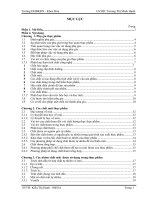General gums presentation Phụ gia thực phẩm ( food additives)
Bạn đang xem bản rút gọn của tài liệu. Xem và tải ngay bản đầy đủ của tài liệu tại đây (3.66 MB, 43 trang )
GUMS IN FOODS
PHJ CPKelco 10/04
The Wide Use Of Gums
• Food
• Industrial
– Textiles, explosives, oil field, cleaners,
pesticides, animal feeds, air fresheners
• Pharmaceutical
– Tablets, syrups, capsules
• Personal Care
– Toothpaste, shampoos, lotions
PHJ CPKelco 10/04
Schedule 2
Prescribed Name
INS No. (E-Number)
Gum Arabic
Agar
Alginic Acid
Sodium Alginate
Potassium Alginate
Calcium Alginate
Propylene Glycol Alginate
Arabinogalactan
Carrageenan
Processed Eucheuma Seaweed
Guar Gum
Karaya Gum
Gellan Gum
Hydroxy Propyl Methyl Cellulose
Locust Bean Gum
Methyl Cellulose
Pectin
Sodium Carboxy Methyl Cellulose
Cellulose, Microcrystalline & Powdered
Tragacanth Gum
Xanthan Gum
414
406
400
401
402
404
405
409
407
407a
412
416
418
464
410
461
440
466
460
413
415
PHJ CPKelco 10/04
Schedule 2
Prescribed Name
INS No. (E-name)
Acetylated Distarch Adipate
Acetylated Distarch Phosphate
Acid Treated Starch
Alkaline Treated Starch
Bleached Starch
Dextrin Roasted Starch
Enzyme Treated Starch
Hydroxypropyl Distarch Phosphate
Hydroxypropyl Starch
Monostarch Phosphate
Oxidised Starch
Phosphated Distarch Phosphate
Pregelatinised Starches
Starch Acetate
Starch Sodium Octenylsuccinate
Acetylated Distarch Adipate
Acetylated Distarch Phosphate
Acid Treated Starch
Alkaline Treated Starch
Bleached Starch
Dextrin Roasted Starch
Enzyme Treated Starch
1422
1414
1401
1402
1403
1400
1412
1405
1442
1440
1410
1413
Depends on Modification
1420/1421*
1450
1422
1414
1401
1402
1403
1400
1412
PHJ CPKelco 10/04
Gums
• “Sugar” based polymers – long chains of
repeating molecules
• Can be straight or branched forms
PHJ CPKelco 10/04
May be
• Plant or animal sources
• Simple products – extractives & flours
• Process - Physically modified
• Process - Chemically modified
• Completely synthesized
PHJ CPKelco 10/04
• Usually in powder form
• Mostly only functional in water
• Generally not attracted to or functional in
fats
PHJ CPKelco 10/04
• They are not “emulsifiers” (surface active
agents)
• But they can help stabilize emulsions
PHJ CPKelco 10/04
• Common useful functions include
– Modify viscosity
• Increase viscosity profile
• Change viscosity profile
• Or both the above
– Provide gelation
– Protein protection
PHJ CPKelco 10/04
Physical Benefits
•
•
•
•
•
•
•
•
•
Gelation
Suspend Particles
Prevent syneresis
Add mouth-feel
Retard crystal growth
Enhance spreadability
Restore form and texture
Aid whippability
Form films
PHJ CPKelco 10/04
Why Use Gums in Foods ?
• Process Aid
• Product Recipe Optimization
• Convenience
PHJ CPKelco 10/04
• Modify foods for consumer preferences
– Religious
• Halal
• Kosher
–
–
–
–
Vegetarian
Genetically Modified Origin
Natural
Organic
PHJ CPKelco 10/04
Origins and Sources
•
•
•
•
•
Plant Exudates
Flours
Bacterial Exudates
Plant Tissue Extracts
Animal (Proteins)
PHJ CPKelco 10/04
Plant Exudates
• Gum acacia
• Gum tragacanth
• Gum karaya
PHJ CPKelco 10/04
Plant Flours
• Guar gum
• Locust Bean Gum
• Tara gum
PHJ CPKelco 10/04
GUAR GUM
Seeds & pods of Cyamopsis tetragonolobus
PHJ CPKelco 10/04
LOCUST BEAN GUM
• Ground endosperm of legume seed
(Ceratonia siliqua)
PHJ CPKelco 10/04
LOCUST BEAN GUM
PHJ CPKelco 10/04
Plant Extracts
From Land Plants Sources
• Cellulosics (cotton, wood)
– “CMC” Carboxymethylcellose etc
•
•
•
•
Pectins (citrus,beet, apple, sunflower)
Konjac (tuber)
Starches (cereals, beans, roots)
Plant Proteins (cereals)
PHJ CPKelco 10/04
Plant Extracts
Water Plant Sources
• Red Seaweed Extracts
– Agar
– Carrageenan
• (kappa, iota & lambda Carrageenans)
• Brown Seaweed Extracts
– Algin
• Alginic Acid, Algin Salts, Propylene Glycol
Alginate (PGA)
PHJ CPKelco 10/04
Microbial Gums
• Xanthan gum
• Gellan gum
PHJ CPKelco 10/04
Applications
• Some gums are more multi-purpose than
others
• Each gums has applications where it
excels
• It depends on the chemistry and process of
the food concerned
PHJ CPKelco 10/04
Dispersion & Hydration
• Hydrocolloids need full solubility in water
for best performance
• Many performance problems occur
because of poor dispersion & / or hydration
• Performance is best when allowed to
hydrate alone in water at low
concentrations – but this is often not
practical
PHJ CPKelco 10/04
• Some stabilizer ingredients are cold
soluble
• This means that the powder hydrate
(“solubilise”) in solution “cold” (<35°C)
• Other stabilisers require heating or
mechanical shear to fully dissolve
• Heating or shear requirements vary
• Some have a high dependence on
mechanical shear
PHJ CPKelco 10/04
Dispersion & Hydration
• Dispersion
– Separating the crystalline granules evenly
though the water
• Hydration
– The granules imbibe water to move from the
crystalline state into the dissolved state
PHJ CPKelco 10/04









